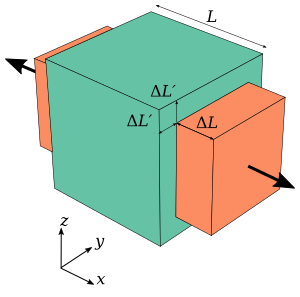Poisson's ratio facts for kids
Poisson's ratio (letter v) is a measure of the contraction that happens when an object is stretched. This contraction is perpendicular to the stretching force. It can also expand as the object is compressed in a perpendicular direction.
For example, if a block is being stretched as shown in the image to the right, the equation for the poisson's ratio will be:
Poisson's ratio ranges from 0.0-0.5 for common materials, though for materials with certain structures, can be as low as -1. A material with a Poisson's ratio close to 0 (like cork) can be stretched a lot in the axial direction without changing much at all in the transverse, where as pulling on a material with a high Poisson's ratio (like rubber) will cause it to become much more narrow. A material with a negative Poisson's ratio will expand in all directions as it is stretched.
Images for kids
-
Influences of selected glass component additions on Poisson's ratio of a specific base glass.
See also
 In Spanish: Coeficiente de Poisson para niños
In Spanish: Coeficiente de Poisson para niños



 due to tension, and contracted in the y and z directions by
due to tension, and contracted in the y and z directions by  .
.
